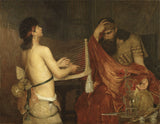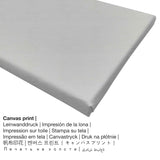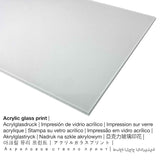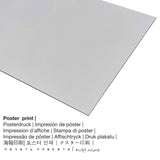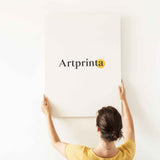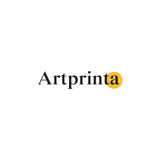Ernst Josephson, 1878 - David na Sọl - ọmarịcha nka
Ụtụ gụnyere. Mbupu gbakọrọ na ndenye ọpụpụ.
Họrọ ụdị ihe dị iche iche
Nchịkọta nhọrọ ndetu ngwaahịa na-enye gị ohere ịhọrọ akụrụngwa yana nha dabere na mmasị gị. Ị nwere ike ịhọrọ n'ime nhọrọ nhazi ngwaahịa ndị a:
- Mbipụta kwaaji: The canvas print is a printed cotton canvas mounted on a wood stretcher. It creates a particular impression of three dimensionality. In addition to that, a printed canvas creates a cosy, enjoyable impression. Your printed canvas of your favorite masterpiece will let you turn your individual art print into a large size artwork. The great advantage of canvas prints is that they are relatively low in weight, which means that it is easy and straightforward to hang up your Canvas print without the use of any wall-mounts. A canvas print is suitable for any type of wall.
- Aluminom dibond (ọkpụkpụ ọla): This is a metal print manufactured on aluminium dibond material with a true depth - for a modern impression and a non-reflective surface structure. The Aluminium Dibond Print is your excellent introduction to art prints with aluminum. For your Direct Aluminium Dibond option, we print your work of art onto the aluminium composite surface. The bright components of the work of art shimmer with a silky gloss, however without any glow. The UV print on aluminium is the most popular entry-level product and is a truly sophisticated way to display art prints, since it draws focus on the artwork.
- Bipụta akwụkwọ mmado n'ihe kwaaji: The poster is a printed cotton canvas paper with a slightly roughened structure on the surface. A print poster is particularly suited for framing the art print using a custom-made frame. Please keep in mind, that depending on the absolute size of the canvas poster print we add a white margin of around 2-6 cm around the work of art, which facilitates the framing with a custom frame.
- Glass acrylic e biri ebi (nwere ezigbo mkpuchi iko): The print on acrylic glass, which is sometimes named as a print on plexiglass, transforms your selected original into marvellous décor and forms a great alternative to canvas or aluminium dibond prints. The artwork is being printed with the help of state-of-the-art UV direct printing machines. Our acrylic glass protects your selected fine art print against light and external influences for many more years to come.
Nkwupụta iwu: We strive to describe our art products as exact as possible and to showcase them visually on the various product detail pages. Nevertheless, the tone of the printed materials and the printing can vary to a certain extent from the representation on your monitor. Depending on your settings of your screen and the nature of the surface, not all color pigments are printed as exactly as the digital version depicted here. Considering that all art reproductions are printed and processed manually, there may as well be minor discrepancies in the motif's exact position and the size.
Ihe osise"David and Saul"dị ka art copy
David and Saul is a painting by the impressionist Swedish artist Ernst Josephson n’afọ 1878. The over 140 year-old original measures the following size of Height: 110,5 cm (43,5 ″); Width: 144 cm (56,6 ″) Framed: Height: 152 cm (59,8 ″); Width: 185 cm (72,8 ″). Moveover, the artpiece is included in the National Museum nke Stockholm mkpokọta nka. Nke a ngalaba ọha piece of art is included with courtesy of Nationalmuseum Stockholm & Wikimedia Commons.In addition, the work of art has the creditline: . Besides this, the alignment of the digital reproduction is in odida obodo usoro ma nwee oke nke 4: 3, nke pụtara na ogologo bụ 33% ogologo karịa obosara. The poet, painter Ernst Josephson was an artist, whose art style was primarily Impressionism. The artist was born in the year 1851 na Stockholm, Stockholm County, Sweden na nwụrụ anwụ na afọ nke 55 na 1906.
Ozi nka ahaziri
| Aha nka nka: | "David na Sọl" |
| Nhazi nka nka: | sere |
| Okwu nche anwụ: | nkà nke oge a |
| Century: | 19th narị afọ |
| Emepụtara n'afọ: | 1878 |
| Afọ nka: | karịa afọ 140 |
| Nha nke ihe osise izizi: | Ogologo: 110,5 cm (43,5 ″); Obosara: 144 cm (56,6 ″) Ekebere: Elu: 152 cm (59,8 ″); Ogologo: 185 cm (72,8 ″) |
| Egosiputara na: | National Museum nke Stockholm |
| Ebe ngosi nka: | Stockholm, Obodo Stockholm, Sweden |
| Dị n'okpuru: | National Museum nke Stockholm |
| License: | ngalaba ọha |
| Site n'aka: | Nationalmuseum Stockholm na Wikimedia Commons |
data ndabere ngwaahịa
| Nkewa bipụta: | ọmarịcha nka |
| Mmeputakwa: | dijitalụ mmeputakwa |
| Usoro nhazi: | mbipụta dijitalụ |
| Mmalite nke ngwaahịa a: | German mmepụta |
| Stockdị ngwaahịa: | na mmepụta ihe |
| Ojiji ngwaahịa: | ụlọ mmepụta ihe nka, ụlọ akwụkwọ nka |
| Nhazi nka nka: | nhazi odida obodo |
| Oke akụkụ onyonyo: | 4:3- (ogologo: obosara) |
| Ntụgharị nkọwa akụkụ akụkụ: | ogologo bụ 33% ogologo karịa obosara |
| Ụdị dị iche iche dị: | akwụkwọ mmado (akwụkwọ kwaaji), mbipụta ọla (aluminium dibond), mbipụta kanvas, mbipụta iko acrylic (nwere ezigbo mkpuchi iko) |
| Nhọrọ nke Canvas Mbipụta (akwa akwa na etiti ihe ndọtị): | 40x30cm - 16x12", 80x60cm - 31x24", 120x90cm - 47x35", 160x120cm - 63x47" |
| Acrylic glass print (nwere ezigbo mkpuchi iko) nhọrọ: | 40x30cm - 16x12", 80x60cm - 31x24", 120x90cm - 47x35" |
| Nhọrọ nha nke akwụkwọ mmado (akwụkwọ kwaaji): | 40x30cm - 16x12", 80x60cm - 31x24", 120x90cm - 47x35" |
| Mpempe akwụkwọ Dibony (ihe alumnium) nha: | 40x30cm - 16x12", 80x60cm - 31x24", 120x90cm - 47x35" |
| Nhazi nke nka nka: | na-enweghị etiti |
Onye na-ese ihe
| aha: | Ernst Josephson |
| Aha ndi ozo: | Ernst Josephson, Josephson Ernst, יוספזון ארנסט, Josephson Ernst Abraham |
| okike nke onye nka: | nwoke |
| Obodo onye nka: | Swedish |
| Ọrụ onye na-ese ihe: | onye na-ede uri, onye na-ese ihe |
| Obodo onye nka: | Sweden |
| nhazi ọkwa: | omenkà nke oge a |
| Ụdị nke onye na-ese ihe: | Mmetụta |
| Afọ ọnwụ: | 55 afọ |
| Afọ ọmụmụ: | 1851 |
| Ebe amụrụ onye: | Stockholm, obodo Stockholm, Sweden |
| Afọ nwụrụ: | 1906 |
| Obodo ọnwụ: | Stockholm, obodo Stockholm, Sweden |
© Copyright - Artprinta (www.artprinta.com)

